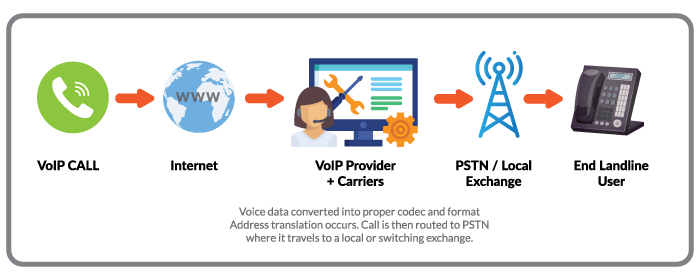If your business uses a VoIP phone system, but your customers or partners still use landline phones – how do you communicate with them? In this article, we will discuss how VoIP to PSTN calls connect and methods for establishing this connection. But first, let’s quickly recap the difference between these networks.
The Basics of VoIP to PSTN
The Public Switched Telephone Network (PSTN) uses circuit switching technology to transmit calls over physical phone lines and cables. And a central office (also known as a local or switching exchange) connects callers to a PSTN line and routes calls to their appropriate destination.
This process used to be done by hand, and calls needed a dedicated communication channel or circuit for the duration of the call. Now, the PSTN is mostly digital and uses automatic electronic switching – meaning multiple calls can share the same wire. But even though the PSTN has been digitized, it still uses physical cables to deliver calls internationally. This means more expenses related to maintenance and equipment for your business.
Voice Over Internet Protocol (VoIP) uses packet-switching technology that transmits calls digitally through the internet. This technology converts voice data into digital packets and then delivers it to the recipient across an IP network.
Since these packets look for the most efficient routes, they may travel differently. Once these packets reach their destination, they reassemble into audio for a seamless transmission. Because this system uses the internet instead of physical lines, it is overall more affordable and increases your system’s functionality.
How Do VoIP and PSTN Networks Interact?
It’s clear that VoIP and PSTN operate differently. But for VoIP calls to reach traditional telephones, they must travel over the PSTN. So, how do these networks connect?

When you place a VoIP call to a PSTN line, the process begins the same as a VoIP to VoIP call. Your analog voice is converted into digital data packets. These packets travel to your VoIP provider and their carriers using the internet as a pathway. Alternatively, the packets may pass through your own media gateway if you establish your own VoIP to PSTN connection. More on that later.
At this point, either your provider or your own infrastructure (VoIP gateway, PBX, soft-switch) converts the voice data into the proper voice codec and format, if necessary. And this is also when the address translation process occurs. During this process, the IP address attached to the voice packets is rewritten into the receiver’s phone number. This way, your voice data can successfully travel over the PSTN and route to your desired destination.
From there, your call routes to the public switch telephone network, where it arrives at a central office. This switching exchange connects subscribers to a PSTN line. Once your call arrives here, the exchange recognizes the landline phone number and sends it to the precise location.
Note that while this process sounds drawn-out and complex, it happens so fast that your call experience is not disrupted.
Methods for Establishing a VoIP to PSTN Connection
Now, let’s look at the main two methods for connecting your business VoIP system to the PSTN:
Do It Yourself
If businesses want to establish a VoIP to PTSN connection, they can do this themselves. Whether you choose to implement your infrastructure on-premise or in the cloud, this method requires you to purchase the necessary hardware and software, including:
- VoIP architecture
- Telecom provider
- VoIP gateway, PBX, or softswitch
- SIP Trunks and so on.
On top of that, you’ll also need to invest in expert staff who specialize in telephony, VoIP, and computer networking. And your infrastructure will also need routine maintenance and upgrades – adding to the overall expense of this option. So, while it is possible to DIY a VoIP to PSTN connection, it is overall more costly and complicated than the alternative.
Get a VoIP Provider
Instead of dealing with the hassle and expense associated with configuring your own system, you can get a hosted VoIP provider. With this option, the provider handles the VoIP to PSTN connection on behalf of your business, saving you time, money, and frustration. Start by simply signing up with a reliable provider, logging in to your account, and making calls. There’s no additional equipment or setup required.
Importance of Including PSTN Within Your VoIP Infrastructure
Although VoIP is a popular communication method, fixed-lines and plain old telephone services are still in use today. This means your business may have to make outbound calls to landline numbers in order to reach certain customers, clients, prospects, suppliers, and so on.
VoIP calls made to other VoIP networks avoid the PSTN altogether. However, VoIP calls made to fixed-lines and POTS must travel over the PSTN. In other words, if you place a call to a residential or business landline, you’ll use the PSTN to establish a connection.
With a VoIP to PSTN connection, you’ll be able to expand your reach, target a broader consumer base, and grow globally.
Start with a Reliable VoIP Provider
Although VoIP networks are gradually replacing PSTN, it’s important to keep this connection in place until PSTN is entirely phased out. Otherwise, you’ll lose out on potential business opportunities and risk losing customers.
Placing VoIP calls to landline users is easy with the right provider. Over the course of 25 years, United World Telecom has established relationships with Tier-1 carriers and other telecom partners to deliver VoIP calls to the PSTN worldwide. Our service offers access to advanced communication features, a dedicated account manager, a 99.999% uptime guarantee, quick activation times, and 24/7 global customer support.
Ready to make VoIP to PSTN calls without any hassle? Speak with our dedicated telecom experts at +1 (561) 276-7156, or chat with us online today!


